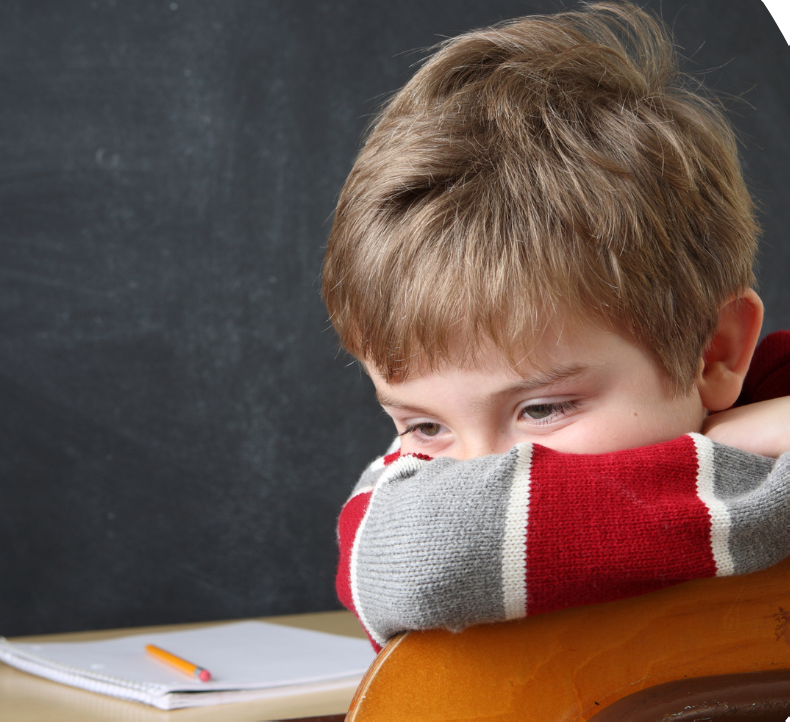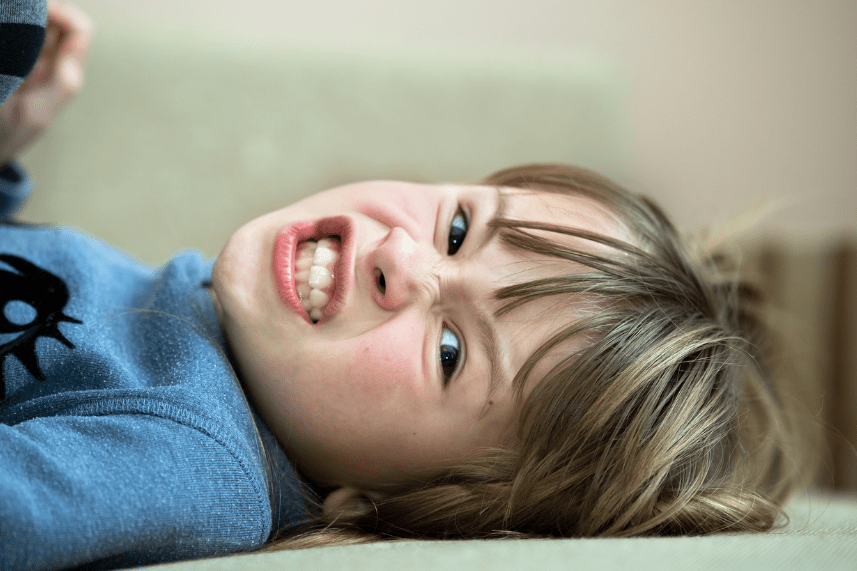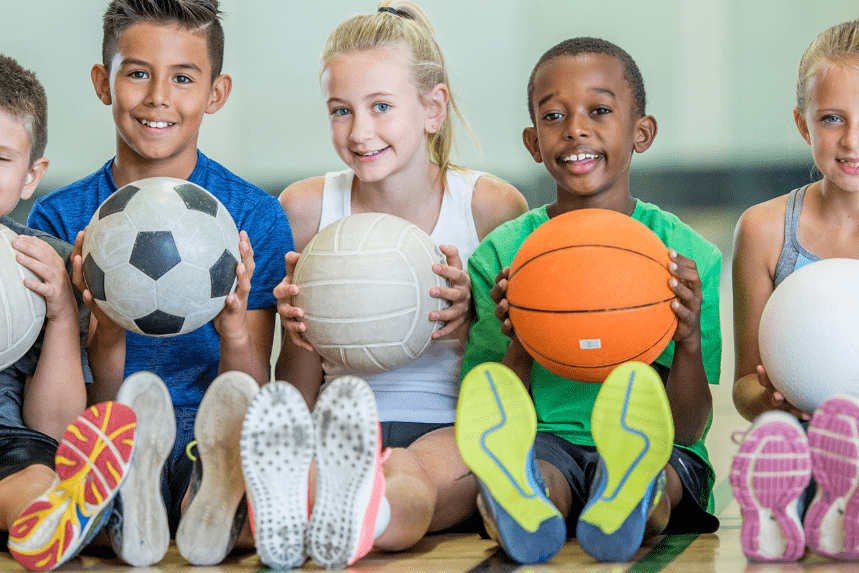How children experience ADHD in the brain & body

Attention Deficit Hyperactivity Disorder (ADHD) is a neurodevelopmental disorder characterized by symptoms of inattention, hyperactivity, and impulsivity.
It’s much more than that though.
A child with ADHD functions inside very differently. The way their brain processes information changes the way they think while doing the very same things you do.
It’s a completely different experience in the body, not just the brain.
The nervous system of a person with ADHD has several key differences compared to those without the disorder. These differences can affect various bodily sensations and experiences, as well as the fight-or-flight response. ADHD brains may not linger on unpleasant issues however, that also means that these children leave somatic discomforts unaddressed. That lingering stress in the body becomes sensitivity that fuels triggers in the future.
That’s why it’s our mission to help children become mindful of bodily sensations. This awareness helps reduce the intensity of high emotional arousal significantly! It is body awareness that helps these children become mindful, better behaved and more in control of their inner and outer worlds.
Changes in the Brain:
Structural Differences
Brain Size and Volume: Studies have found that certain brain regions, particularly the prefrontal cortex, caudate nucleus, and cerebellum, tend to be smaller in individuals with ADHD. These areas are crucial for executive functions such as decision-making, attention, and impulse control.
Cortical Thickness: The development of the cerebral cortex, which is responsible for many higher-order brain functions, can be slower in people with ADHD. This can explain why children with ADHD need slightly more time to process complex information or multi-step instructions.
Gray Matter and White Matter: Variations in the density and distribution of gray matter and white matter has also been observed. These differences can affect how brain regions communicate with each other.
Functional Differences
Brain Activity: Functional MRI (fMRI) studies have shown that individuals with ADHD often have altered patterns of brain activity, especially in the default mode network (DMN) and the fronto-striatal circuitry. The DMN is associated with daydreaming and self-referential thoughts, while the fronto-striatal circuitry is involved in regulating attention and behavior.
Neurotransmitter Systems: Dopamine and norepinephrine, two key neurotransmitters involved in attention and executive function, are often dysregulated in ADHD. This dysregulation can lead to difficulties in maintaining focus, regulating emotions, and controlling impulses.
Changes in the Body:

The nervous system of a person with ADHD has fundamental differences that impact how the body experiences the world. These varying impacts can affect the automatic reactions a person has to bodily sensations, new experiences, rejection, frustration as well as the body’s automatic fight-or-flight responses.
Nervous System Differences in ADHD
Neurotransmitter Dysregulation:
- Dopamine: Children with ADHD have lower levels of dopamine, a neurotransmitter associated with reward and motivation. This can affect focus, attention, and the ability to experience pleasure from everyday activities.
- Norepinephrine: This neurotransmitter, which plays a role in attention and arousal, is also often dysregulated in children with ADHD, leading to difficulties in maintaining alertness and responding to stress appropriately.
Autonomic Nervous System (ANS) Function:
The ANS, which regulates involuntary bodily functions such as heart rate, digestion, and respiratory rate, may function differently in individuals with ADHD. There can be an imbalance between the sympathetic nervous system (responsible for the fight-or-flight response) and the parasympathetic nervous system (responsible for rest and digestion).
Sensory Processing:
Children with ADHD often have atypical sensory processing. They may be hypersensitive or hyposensitive to sensory stimuli such as sounds, lights, touch, and even internal body sensations. This can lead to either overreaction to sensory input or a lack of responsiveness to it depending on the child.
Differences in Body Sensations and Experiences
Heightened Sensitivity:
Individuals with ADHD may experience heightened sensitivity to sensory input. This can look like feeling easily overwhelmed by loud noises, bright lights, or busy environments.
Proprioceptive and Interoceptive Awareness:
Proprioception (awareness of body position and movement) and interoception (awareness of internal body states) can be affected. This might manifest as clumsiness, difficulty in coordinating movements, or challenges in recognizing bodily signals such as hunger or the need to use the bathroom.
Restlessness and Hyperactivity:
A common experience for those with ADHD is a sense of internal restlessness. This can translate into physical hyperactivity or an internal feeling of being constantly “on the go.”
Fight-or-Flight Response in ADHD
Enhanced Stress Response:
Individuals with ADHD may experience an exaggerated fight-or-flight response. This means they might react more intensely to stressors or perceived threats. Their bodies can go into a heightened state of arousal more quickly and take longer to return to a baseline state.
Emotional Reactivity:
Emotional dysregulation is a common feature of ADHD. This can lead to more pronounced emotional responses during stressful situations. For example, an individual with ADHD might experience more intense fear, anger, or anxiety in response to a triggering event.
Difficulty with Regulation:
Due to differences in neurotransmitter function, people with ADHD may have trouble regulating their fight-or-flight response. This can make it harder to calm down after a stressful event and can lead to prolonged periods of anxiety or agitation.
Impulsive Reactions:
The impulsivity associated with ADHD can influence the fight-or-flight response, leading to quick, unplanned reactions to stress. This might mean acting without thinking through the consequences, which can escalate stressful situations.

Living with ADHD and Nervous System Differences
Coping Strategies:
Individuals with ADHD often develop specific strategies to manage their sensory sensitivities and stress responses. These might include using noise-cancelling headphones, practicing mindfulness and relaxation techniques, or engaging in regular physical activity to help regulate their nervous system.
Therapeutic Interventions:
Treatments such as cognitive-behavioral therapy (CBT), occupational therapy, and sensory integration therapy can help individuals with ADHD manage their symptoms. Medications that regulate neurotransmitter levels can also play a crucial role in helping balance the nervous system.
Supporting children with ADHD:
ADHD brains may not linger on unpleasant issues, leaving somatic discomforts unaddressed. Somatic therapy for people with ADHD begins with learning to be mindful of bodily sensations, which can eventually help reduce the intensity of high emotional arousal.
Somatic or body-based coping skills can be highly effective for individuals with ADHD in managing their symptoms and regulating their nervous system. These techniques focus on using physical and sensory experiences to create a sense of calm, improve focus, and enhance emotional regulation. Here are several body-based coping skills that can help:

1. Physical Exercise
- Aerobic Activities: Activities such as running, cycling, swimming, or dancing can help release endorphins and regulate neurotransmitter levels, improving mood and attention. Our favorite skill taught to children with ADHD is doing short bursts of exercise before sitting down to do homework or school projects. Getting tired from quick, intense exercise helps these brains focus and work better. Challenge your child to do jumping jacks, push ups or squats for a minute or two before sitting down to work to try this productivity hack!
- Strength Training: Weightlifting or body-weight exercises can provide a structured and repetitive form of physical activity that helps with focus and self-discipline. Teenagers with ADHD can find joining a sport or starting a physical exercise routine extremely helpful to controlling their ADHD symptoms.
- Yoga and Pilates: These practices combine physical movement with mindfulness and breath control, promoting relaxation, balance, and body awareness. This helps children slow thoughts down and bring mindfulness down into the body, which is practice for other experiences throughout the day.
2. Breathing Techniques
- Deep Breathing: Slow, deep breathing can activate the parasympathetic nervous system, helping to calm the body and mind. Deep “belly breathing” involves inhaling slowly through the nose, allowing the chest and belly to rise. Hold each breath for four seconds, then release it through the mouth for four seconds. By fully expanding the lungs, this technique counteracts the rapid, shallow breathing that accompanies panic, and calms the amygdala, the brain’s emotion processing center.
- Box Breathing: This involves inhaling for four counts, holding for four counts, exhaling for four counts, and holding again for four counts. It helps in reducing stress and enhancing focus.
3. Mindfulness and Meditation
- Mindfulness Meditation: Practicing mindfulness helps individuals become more aware of their thoughts and feelings without judgment. It can improve attention and reduce impulsivity.
- Body Scan Meditation: This involves mentally scanning the body from head to toe, paying attention to physical sensations. It is the first and main practice we promote for children with ADHD because it teaches them a relaxation skills and body awareness that becomes the training they need to achieve better behavior and health throughout their entire lives.
4. Sensory Activities
- Weighted Blankets: The deep pressure stimulation from weighted blankets can have a calming effect on the nervous system.
- Sensory Toys: Fidget spinners, stress balls, or tactile toys can help individuals with ADHD stay focused and reduce anxiety by providing a physical outlet for restlessness.
- Essential Oils: Aromatherapy using essential oils like lavender, chamomile, or peppermint can promote relaxation and focus.
5. Body-Based Therapies
- Occupational Therapy: Occupational therapists can provide sensory integration therapy, helping individuals with ADHD manage sensory processing issues through tailored activities.
- Somatic Experiencing: This therapeutic approach focuses on creating a stronger brain and body connection so that body awareness of physical sensations are noticed and dealt with. Greater body awareness facilitates better behavior and the releasing trauma stored in the body, which has proven to help individuals with ADHD regulate their stress responses.
6. Grounding Techniques
- Progressive Muscle Relaxation: This involves tensing and then slowly releasing different muscle groups in the body, promoting physical and mental relaxation. This is the number 1 exercise we recommend for building a strong brain-body awareness.
- 5-4-3-2-1 Technique: Identifying five things you can see, four things you can touch, three things you can hear, two things you can smell, and one thing you can taste can help ground individuals in the present moment and reduce anxiety.
7. Structured Routine
- Daily Schedule: Maintaining a consistent daily routine can help manage time more effectively and reduce the chaos that can exacerbate ADHD symptoms. Children with ADHD are more easily impacted by unpredictability and hectic days, which means that they may begin to act more negatively when their routine is changed unexpectedly. The predictability of routines help a child’s nervous system remain in states of safety. Predictability also helps children with ADHD prepare mentally and physically for experiences so they can bring coping items, use strategies that have worked before or use pre-planned calming options.
- Break Tasks into Smaller Steps: Breaking tasks into manageable chunks and using checklists can help a child with ADHD maintain focus and reduce feelings of being overwhelmed.
8. Nutrition and Hydration
- Balanced Diet: Eating a diet rich in whole foods, including fruits, vegetables, lean proteins, and whole grains, can help regulate energy levels and improve cognitive function.
- Stay Hydrated: Adequate hydration is essential for optimal brain function and can help maintain focus and reduce irritability.
9. Sleep Hygiene
- Consistent Sleep Schedule: Going to bed and waking up at the same time every day can help regulate the body’s internal clock and improve sleep quality. Changing sleeping habits can make significant impacts in improving a child’s ability to focus and cranky behavior. All children need consistent sleep schedules that take their developmental needs into account, but children with ADHD can show symptoms of sleep imbalances quickly and severely.
- Relaxation Techniques Before Bed: Practices like reading, listening to calming music, or taking a warm bath can signal to the body that it’s time to wind down. This is especially important for children that are more stimulated than normal by fast paced shows, high pitches and bright, colorful media.

Helping Children with ADHD
Extra Support for Children with ADHD
CREATE uses a family first approach that focuses on building connection between parent and child. We combine that with a body centered framework that aims to build a child’s capability to identify, sit with and process strong feelings.
Contact us to work with our therapist if you are interested in addressing your child’s specific needs with our approach. We offer one-on-one therapy, homework and school support, activities focused on improving the family and more.
